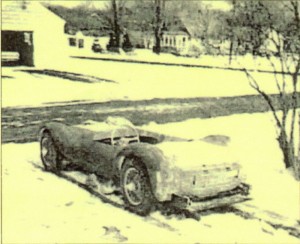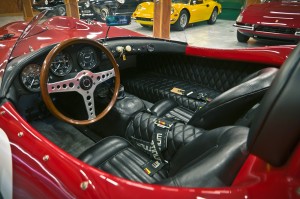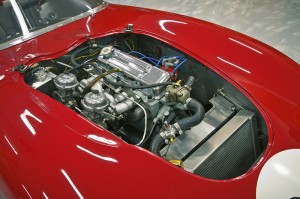

The Original Shape Created By Rhodes Was Quite Different Than The Final Design And Build of His Fiberglass Bodied Morgan Special.
Hi Gang…
I have the honor of again welcoming Jim Simpson of “Simpson Design” to our flock of fiberglass fanatics and have asked Jim if he would be willing to contribute stories from time to time to Forgotten Fiberglass.
I’m honored that Jim accepted the offer and today is another in a series of stories and “adventures in ‘glass” by fiberglass aficionado and good friend…Jim Simpson.
Take it away Jim!
—————————–
The 1956 Morgan +4 One-Off Sports Racer
Written By Jim Simpson
Photos By Chuck Simpson
I am constantly amazed at the East Coast’s history of remarkable cars and the people who built them, particularly in the New York area. I’ve wondered countless times if it’s due to the huge population in that area or because New York car shows were so well attended, or people are just plain better car educated. What I do know is that custom car building in the 50’s and 60’s and perhaps even now, is as prolific in the Northeast as in California.
A few years ago I attended the Barrett Jackson Auction with one of my clients. We were both dumbstruck by this lovely little Morgan Sports racer. Primarily a Ferrari collector, my client’s sudden enthusiasm took me by surprise. I reminded him of our rule about buying cars at auctions, that we know going in what our max bid will be and we don’t get caught up in the moment…
The car started out life as a typical (if there is such a thing) 1956 Morgan plus 4, chassis #4021. Sold new in New York by Fergus Motors, it was resold as a used car in November of 1958 to Cecil J. Rhodes of Bemis Point, New York. Shortly after Rhodes bought the car, it was involved in an accident that made a mess of the front fenders and grille cowl area.
The car was repaired but not to Rhodes’s satisfaction. Though he continued to drive it through the next year, he had largely lost interest in it. He stuck it in the garage, deciding he’d rebody it later.
In the summer of 1963 Rhodes stripped the Morgan factory body from the car and started making design studies. He was fascinated with the Scaglietti bodied Ferrari Mondial, arguably one of the prettiest race cars of the day and one that I believe Bill Devin must have been inspired by as well.
The following summer, starting with bits of corrugated cardboard over the existing mechanicals of the Morgan, he experimented with scale and shape. Wanting to keep the body of the car very tight over the chassis, he used foam clay and plaster to achieve his vision and then began adding fiberglass.
By fall, he had completed the car to the point of being ready for trimming the interior and started driving it. Hoping to get more out of the engine, he took it to a mechanic, who proceeded to somehow ruin the TR3 motor.
It was the final blow for Rhodes; in disgust he put the car away and it remained untouched until 1978.
The fiberglass work done by Rhodes was lightweight and very high quality. I don’t know if he was just very talented and capable or if he’d had previous experience. It’s also not clear if it was Rhodes who hand fabricated the lovely egg crate grille, the windshield and very elaborate chrome script on the rear of the trunk lid.
Interestingly, the frame around the inside of the trunk lid is metal. Notice the car has no doors; it does have high fiberglass sills inside that clearly add to the structural rigidity of the body.
The car traded hands several times until enthusiast John Hammond in Michigan bought the car restored and brought it almost to completion for his client Terry Mahrle. In 1990 it was auctioned off by Rick Cole Auctions to John Hibbard of Cardiff, CA. Hibbard stuck it in his collection and hardly drove it, selling it on in 1996 to another collector, Jay Hoffman of Scottsdale AZ for his extensive collection.
What this tedious history of disuse and owner change illustrates is that regardless of how distinctive, prestigious or unusual cars may be, they often disappear from the public eye for years at a time. And we collectors and enthusiasts tend to give them up for lost.
Early in 2004 the car was sold again to Park Place Motors in Bellevue, Washington. Park Place displayed the car amidst their usual grouping of amazing cars for sale for nearly a year. Finally despairing of finding a buyer locally, they put the car in the Barrett Jackson Auction, where my client and I found it, a lovely little fiberglass bodied enigma.
So much for rules – my client made the decision to take it home. It is the ultimate irony that another Washingtonian had to travel hundreds of miles to discover a car that sat only 40 miles away from him for nearly a year.
Since then, I’ve had the pleasure of doing extensive mechanical rebuilding, including brakes, steering, and cooling system, and much work on the engine and carburetion. Somewhere in its travels, the car acquired a 60’s TR4 engine which it has to this day.
We have done a lot of cosmetic refurbishment as well – rebuilding gauges, restoring the wrinkle finish on the dash, and repairing the instrument binnacle. We also re did much of the engine compartment, which was looking pretty tired.
Kenny Arnold, a good friend and terrific upholstery man in Texas, remade much of the interior, including all the Wilton carpets and quilted leather work. The car has also been sympathetically fitted with a fire suppression system, a good idea for older vehicles.
The little Morgan has finally found the right owner in my client and a long term home. It is part of the Black Horse Racing collection and is driven regularly. The car is very lightweight (guessing 1,200 lbs at most) and the performance is sparkling. Even in the midst of terrific Ferrari’s and other race cars in Black Horse Racings collection, that are all much more valuable, the little Morgan is enjoyed and revered.
It has been shown, much to the public’s delight, at many car shows, including the prestigious Classy Chassis Concours in Houston,Texas, this past summer. The Morgan is also no stranger to receiving awards at the shows it attends, and is always a crowd favorite.
Much to his credit, my client is very hands on guy, who built himself a nice, very well equipped, personal work shop. He’s gone out of his way to learn much about all of his cars and is not at all bashful about getting his hands dirty working on them. It’s clear to me he quite enjoys the full experience of car owner and enthusiast.
If you’re ever on Whidbey Island, Washington, on a nice day pretty much any time of the year, don’t be surprised to see the little Morgan special driven by a man sporting racing goggles and a huge grin.
Sadly, as is too often the case with specials, home builds, and kit cars, the people who began the projects aren’t able to see their vision through and never get to enjoy the reward of driving their concepts. But I believe Mr. Rhodes would be pleased to see how the car he conceived and built has become so much appreciated.
Summary:
Thanks again to Jim Simpson of Simpson Design for another fascinating look at a fiberglass sports car special worthy of recognition and respect in every way. I look forward to the next story by Jim and the direction it may take us.
Keep the stories coming Jim and be sure to checkout the latest news on the Simpson Design website by clicking here.
Hope you enjoyed the story, and until next time…
Glass on gang…
Geoff

——————————————————————-
Click on the Images Below to View Larger Pictures
——————————————————————-
- The Original Shape Created By Rhodes Was Quite Different Than The Final Design And Build of His Fiberglass Bodied Morgan Special.
- Great Rear Quarter Shot Of Morgan Special Shows Off Near-Perfect Stance.
- The Finished Cockpit Is Exquisite In Design and Execution. What a Blast This Must Be To Drive!
- Close Up Of Engine of Morgan Special – Finished To A Very High Degree.




























Had no idea this thing existed.
Have known Jim for 30+ years and he continues to amaze and surprise me. Nice guy too…
To see this car is to remember it, as it has an ineffably correct looking Ferrari 860 face on it, while being something altogether different. I have taken the liberty to hotlink it to my FB Blog, Looking Back Racing, if that is okay with the authors. It is exactly the sort of car I get giddy about in that column.
The car was indeed supplied new with wire wheels (at an extra cost of USD 116 pre tax at that time). The only difference would be that in this period the 60 spoke wire wheels were customary, whereas the car now sits on 72 spoke wire wheels. I’d be interested to see pictures of it in 1960, as by then it still was an unfinished project.
Geoff the stories are coming so Fast and Furious I’m having a hard time keeping up with them to make comments..Keep-em coming.. Enjoy reading them all.
One thing I see on the early construction photos is that it has wire wheel. This would have been very rare if it came from the factory that way – most had disc wheels in the 50s with a rather odd bolt pattern. It could be the builder made some custom adapters for the wires. Factory records should show if it was built with wire wheels. Spicer in the UK built the rear-ends for Morgans. They had a Moss transmission [about like Jags] and TR motors.
A truly great car that I had no idea even existed! Thank you so much for sharing this with us.
This is one stunning car! Morgan Motor Co. should have copied this car instead of building their fiberglass Plus Four Plus coupe in 1963 – a car that Morgan fans did not welcome – I think that only 26 were sold.
Jim,
Thank you for the great story. I have a question, though. The body of the Morgan special in the early photos looks nothing like the current body. You mentioned that the photos showed Rhodes’ original design. Did Rhodes do both bodies? Or did someone else build the current body? It looks like a professionally built body available in England. Thanks.
Rhodes apparently did both bodies, one was a modification of the original design, making this body quite unique. As far as we know none of the molds still exist.
cecil Rhodes did both bodies. we agreed that the first design looked like a bottom feeder. on the second body he decided to use his professional traing abd experience with much better results. I assisted him ep to the point of the car being wired . then was drafted to the army and never saw the car again. heartfelt thanks to all that touched the car that they didn’t alter the design. am willing to give any info on the caar or cecil who was one wonderful and talented man. david Rhodes. proud brother
This car gets the award for “most gorgeous non-Italian-Italian-looking car…” The fit and finish is wonderful, much better than almost all of the one-off creations of the era. It certainly is better now than it was when it began it’s journey.
It was not this good until it was restored in Michigan circa 1989/90. All the racing numbers and the white paint around the headlights were added later.
The best part about this site is meeting all the other people with not only similar interest but who also have the fire to keep this interesting old stuff alive. Your all a very special breed in deed, I am honored to be part of this group. Most amazing part of the mysterions is they make the most limited production sports cars look almost common place by comparison. Back to the thrill of the search and then finding out about them.
Any one out there ever heard of a Duiz? A fiberglass sports coupe from the 60’s built on a TR4 platform… I am trying to research that one now, any help will be greatly appreciated.
I do have a bad photocopy of a brochure.
typo – races in 1990
One other thing I have noticed is that in the 1960s photos it has wire wheels. Very few 1950s Morgans had wire wheels. They had an odd wheel bolt pattern, so likely the cars builder adapted these wheels some time after the wreck. Morgan factory records might show if it was a rare wire wheeled car when delivered.
This car was at the June Chicago Vintage Elkart races in 1960. The guy that displayed it was from Michigan. As I recall it was for sale. I took some photos as it was so interesting a design and I had been to the Morgan Factory. One thing to remember is that the Sports Car Club of America started in New York and Conn with the Collier bros and Briggs Cunningham. They had some of the best prewar imported cars in the US. after the war, the major importers were in New York City. Some of the early members of the major Antique Car Clubs built some interesting well designed sports cars. Most were metal bodies.
In the past I shared my photos with several sports car guys and noone had a clue that it was a Morgan. This posting helps fill in the gaps from 1990. Thanks
What a very “special” special.
Imagine a classic Italian inspired car with styling cues from the much loved Ferrari Mondial by Scaglietti, the sturdy heart of a British TR3/TR4 powerplant and the chassis of another British sports car icon, a Morgan yet. Combine this with what looks like 72 spoke wire wheels complete with authentic three-eared knock offs, an estimated Lotus-like weight of only1200 lbs at most, and what must be a power to weight ratio that would embarrass many of the very best exotics, and you have a very special car indeed!
Then add the considerable talents of Jim Simpson to complete the final cosmetic and mechanical sorting and to say grace over the project and what is left, but to enjoy a truly one of a kind automotive treasurse.
Thanks Jim, for sharing with the Forgotten Fiberglass crowd.
The 3 eared knock-offs came on Sunbeam Alpines and coupes of that era.
Jim,
Thank you so very much for sharing this amazing story.
I can relate to the situations in which the original designers, owners and visionaries of these cars never saw the completed product. While sad, it is great to see others pick up and continue on with their vision.
As the owner of a Mysterion that has never been completed, I continue my quest to find out who designed my car and what that vision was so that I may complete it. I is a major challenge, but one I know deserves to be finished.
I look forward to they day when I slip a pair of driving glasses on, give the car a little gas as I let the clutch slip out, and quickly lose the fight to keep an ear to ear grin from plastering itself across my face!
Thank you again. I look forward to more stories.